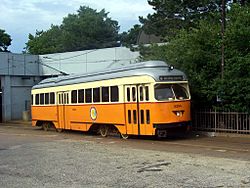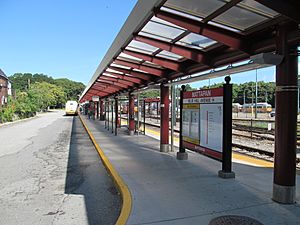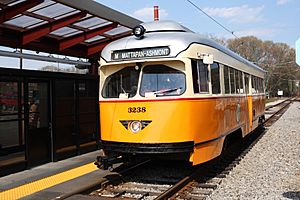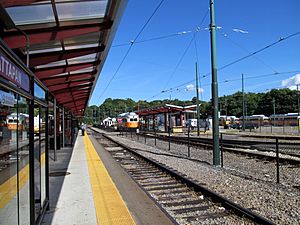Mattapan facts for kids
Quick facts for kids
Mattapan
|
|
|---|---|

The Mattapan-Ashmont Trolley
|
|
| Country | United States |
| State | Massachusetts |
| County | Suffolk |
| Neighborhood of | Boston |
| Annexed by Boston | 1870 |
| Population
(2010)
|
36,480 |
| Time zone | UTC-5 (Eastern) |
| Zip Code |
02126
|
| Area code(s) | 617 / 857 |
Mattapan is a neighborhood in Boston, Massachusetts. Historically a section of neighboring Dorchester, Mattapan became a part of Boston when Dorchester was annexed in 1870. Mattapan is the original Native American name for the Dorchester area, possibly meaning "a place to sit." As of the 2010 census, it had a population of 36,480, with the majority of its population immigrants.
Like other neighborhoods of the late 19th and early 20th century, Mattapan developed, residentially and commercially, as the railroads and streetcars made downtown Boston increasingly accessible. Predominantly residential, Mattapan is a mix of public housing, small apartment buildings, single-family houses, and two- and three-family houses (known locally as "Three-Deckers" or "Triple-Deckers"). Blue Hill Avenue and Mattapan Square, where Blue Hill Avenue, River Street, and Cummins Highway meet, are the commercial heart of the neighborhood, home to banks, law offices, restaurants, and retail shops. The new Mattapan Branch of the Boston Public library opened 2009, at a cost of more than $4 million. Mattapan has a large portion of green space within the neighborhood. The Harambee Park, the Franklin Park Zoo, the Boston Nature Center and Wildlife Sanctuary, Clark-Cooper Community Gardens, and historic Forest Hill Cemetery can all be considered green space within the neighborhood of Mattapan. Mattapan's demographics are diverse, with a large population of Haitians, Caribbean immigrants, and African Americans. Mattapan has public services such as a recently renovated community health center, and constable services. Mattapan has a trolley running through it, which is accessible via Ashmont.
Contents
History
Dorchester was settled by English settlers in 1630. Mattapan was originally a part of Dorchester until the nineteenth century, when it was annexed onto its own neighborhood. The Neponsett Tribe originally settled Mattapan, which was a tribe of the Massachusetts confederation of Native Americans. The name Mattapan originated with this Native American tribe and it is defined as "a good place to be" or "a good place to sit". At the turn of the 20th century, the population of Mattapan was largely Caucasian, but starting in the late 1960s, blockbusting intentionally designed to destabilize the neighborhood drove many long-term residents out of Mattapan. In the 1980s, a significant number of Haitians immigrated to Mattapan, leading to the current demographic population. Mattapan has become an important center for the Haitian cultural, social, and political life in the state of Massachusetts. As of 2015, Mattapan also has a large population of African Americans, Jamaicans, and other Caribbean immigrants.
Demographics
Today Mattapan is seeing another major population shift, albeit a natural turn over of housing, as a large number of immigrants from Haiti and other Caribbean countries continue to move in. Mattapan now has the largest Haitian community in Massachusetts, and is also largely made up of African Americans and immigrants from other Caribbean countries. In 2013 the population in Mattapan was 36,299. Of this total 11% were Caucasian, 82% were African American, 1% were Asian, 2% were a mixed race, and 6.5% were devoted to other races. According to the Boston Redevelopment Authority 72.4% of the population living in Mattapan were born in Massachusetts, 23.6% were born outside of the state, and 3.2% were born outside of the United States. Of those born outside of the United States 33.2% were born in Haiti and 17.2% were born in Jamaica. For the total adult population, 38.9% graduated from high school, while only 14.7% have a bachelor's degree. The median household income in Mattapan is $44,744. There are an average of 12,345 people per square mile.
Citizenship
Approximately 35.6% of Mattapan's population is foreign born, and slightly more than half of those who are foreign born have become United States citizens (53.8% of foreign born citizens). Since 1980, the majority of Mattapan has been inhabited by foreign born citizens, and until about 1990 many of these foreign born inhabitants became U.S. citizens; after the 1990s, many people who immigrated to the United States did not become U.S. citizens[1]. The largest percentage of the population who were immigrants to the United States are Haitian (33.2%), while Jamaicans and Trinidadians make up about 27.6% of Mattapan's population.
Languages
Though Mattapan is racially diverse, the predominant language is English. About 18.9% of the population speak French; this includes the Patois, Creole, and Cajun languages. A small portion of the population speak Portuguese Creole (0.3%)[1]
The languages spoken at home also vary from age; for example, approximately 68.2% of children who are 5–17 years old speak only English, while 16.9% of those children speak other Indo-European languages.[2] Among adults aged 18–24 years, 23.4% speak other Indo-European languages; while 63.9% of adults who are 18 to 24 years old speak English[2].
Demographics
In Mattapan the population was 36,299 in 2013. Of this total, 8.5% were Caucasian, 81% African American, 1% Asian, 2% mixed race and 6.5% other races.[1] According to the Boston Redevelopment Authority, 67.3% of households are family based rather than single men and women or couples. It was also noted that Mattapan has among the highest percentage of people who speak French in their homes.[2] Based on percentages in Mattapan, the cost of living is 8% lower than Boston, the total crime rate is 27% higher compared to Boston, the amount of high school graduates are 11% lower than Boston, employment is 9% lower, and housing is 23% lower than Boston.[1] The majority of homes in Mattapan are triple decker apartment buildings.
Citizenship
Though Mattapan can be seen a diverse city of Boston, approximately 35.6% of Mattapan's population is foreign born, and slightly more half of those who are foreign born have become United States citizens (53.8% of foreign born citizens) [1]. Since 1980, the majority of Mattapan has been inhabited by foreign born citizens, and until about 1990 many of these foreign born inhabitants became U.S. citizens; after the 1990s, many people who immigrated to the United States did not become U.S. citizens[1]. The largest percentage of the population who were immigrants to the United States are Haitian (33.2%), while Jamaicans and people born in Trinidad and Tobago make up about 27.6% of Mattapan's population[2].
Languages
Though Mattapan is racially diverse, one of the predominant languages is English. About 18.9% of the population speak French; this includes the Patois, Creole, and Cajun languages. A small portion of the population speak Portuguese Creole (0.3%)[1]
The languages spoken at home also vary from age; for example, approximately 68.2% of children who are 5–17 years old speak only English, while 16.9% of those children speak other Indo-European languages.[2] Among adults aged 18–24 years, 23.4% speak other Indo-European languages; while 63.9% of adults who are 18 to 24 years old speak English[2].
Current demographics
Today Mattapan is seeing another major population shift, albeit a natural turn over of housing, as a large number of immigrants from Haiti and other Caribbean countries continue to move in. Mattapan now has the largest Haitian community in Massachusetts, and is also largely made up of African Americans and immigrants from other Caribbean countries. In 2013 the population in Mattapan was 36,299. Of this total 8.5% were Caucasian, 81% were African American, 1% were Asian, 2% were a mixed race, and 6.5% were devoted to other races. According to the Boston Redevelopment Authority 72.4% of the population living in Mattapan were born in Massachusetts, 23.6% were born outside of the states, and 3.2% were born outside of the United States. Of those born outside of the United States 33.2% were born in Haiti and 17.2% were born in Jamaica. For the total adult population, 38.9% graduated from High School, while only 14.7% have a bachelor's degree. The median household income in Mattapan is $44,744. There is an average of 12,345 people per square mile.
Income status
The average income status for someone residing in Mattapan is around $44,744 per year as of 2011. 71.3% of the residents working in Mattapan are blue collar workers and the remaining 28.7% are white collar workers. About 64.5% of households are family households, the other 35.5% of the people living in Mattapan are not family households. The medium family income is around $54,119. As of 2011 26.2% of households received food stamps/SNAP. Out of that percentage 49.5% of those households were under the poverty level.
Transportation
The Mattapan-Ashmont trolley line of the MBTA serves Mattapan as well as several bus routes. In the beginning of 2016, the Mattapan trolley was in danger of being derailed and being transformed into bus routes instead, which would be more cost effective than keeping the trolley as rail line. However, Boston officials have fought to cancel this transformation because although this would be more cost effective, property values would decrease and would "most importantly, torpedo a mixed-use, mixed-income residential-retail project slated for the Mattapan station parking lot". At this point in time, the project to convert the Trolley into buses will not be carried out.
The Fairmount Line of the MBTA Commuter Rail also serves Mattapan at the Morton Street and Blue Hill Avenue stations, providing service to downtown Boston and the suburbs. The Fairmount Corridor Commuter Rail Line currently runs from South Station south through the Boston neighborhoods of Dorchester, Roxbury, Mattapan and terminates in Readville section of Hyde Park. It consists of approximately 9.2 miles of track, nine stations (South Station, Newmarket, Uphams Corner, Four Corners / Geneva, Talbot Avenue, Morton Street, Blue Hill Avenue, Fairmount, and Readville) and forty-one bridges. It is the only Commuter Rail Branch that exclusively serves the City of Boston and MBTA's Urban Core.
Green space
- Harambee Park was built in 1961, designed by Frederick Law Olmsted, the famous American Landscape architect. Originally known as Franklin Field, named after Benjamin Franklin.
- The Franklin Park Zoo founded in 1912, "Is considered the crown jewel of the Frederick Law Olmsted's Emerald Necklace Park System.
- The Boston Nature Center and Wild Life Sanctuary is a hidden gem and pride of Mattapan spreading across 67 acres. It is home to over 150 species of bird, 40 species of butterflies and more than 350 species of plants. It has Clark-Cooper Community Garden providing options of fresh food and green spaces to over 250 local families. It also has two miles of trails through meadows and woodlands.
- The Forest Hills Cemetery is a prime example of rural garden cemetery. It has both historic and culture significance of Boston. Founded in 1848 to, "provide a magnificent park-like setting to bury and remember family and friends. It has been added to the National register of Historic Places in 2004.
Community resources
Mattapan United is a community organizing process that connects residents and other leaders to define the future of Mattapan. This resident-led process, convened by ABCD Mattapan Family Service Center, resulted in a community contract that identifies strengths and challenges, and outlines solutions. Mattapan United along with the ABCD Foundation also created 'Mattapan Square Main Streets' promoting Mattapan Square as a culturally and economically rich commercial district in collaboration with residents and.
They offer helps with regards to job opportunities, tax, summer works, computer labs and workshops, education classes for seniors etc. Its mission statement, " is to empower disadvantaged people by providing them with tools to overcome poverty, live with dignity, and achieve their full potential".[6] Also online website like MyMattapan.org and Mattapan United are one stop to know anything about its community. Mattapan United is,"a comprehensive community development initiative that aims at improving the quality of life for people who live and work in Mattapan".[7] It offers resources and serves as platform for people and its organizations, groups, and civic leader to engage and discuss. These are led by their residents which reflects their core community values and adhere to its vision to serve the community.Mattapan Food and Fitness Coalition founded in 2006 is an organization primarily formed to provide its residents of healthy living and eating and space options. It initiates to serve its diverse community on its path to better health. Haitian - American Health Public Health Initiatives, a NGO formed in 1989 with deep interest to serve its Haitian population. But today it has also extended it services to Haitians living in greater Boston area through its comprehensive programs and initiatives.[8]
Urban policies
"The population in Mattapan during the 1960's rose from 500 to over 19,000 in one decade. This was followed by an influx of thousands of Haitians in the 1970s. By 1999, The Boston Globe reported that there were between 70,000 and 120,000 Haitians living in Mattapan, making it one of the largest Haitian communities in Massachusetts." Nowadays Mattapan is still a very popular place to live. Mostly people of color migrate here because of racial segregation, for example, stated in the article, over 90% of the population is made up of people of color, 84% being Black, 7% Latino, 3% White, and 1% Asian. [4] Per capita income in Mattapan for a typical neighborhood is just $14,800.[4]
According to this article, [4] Black and Latino residents in the Mattapan area experience higher levels of chronic disease, mortality, and poorer health than the White residents living in Mattapan.
Urban Renewal has played a great deal in the neighborhood of Mattapan. Then Boston Mayor Thomas Menino put these projects into place in 2006. After increased business and capital investment in commercial areas along with peoples properties, Mattapan became more popular and more of an increasing area that people moved to.[5]
In 2006, Mayor Thomas Menino implemented the Mattapan Economic Development Initiative. Mayor Menino created "MEDI" (Mattapan Economic Development Initiative) so that there was a specific plan and framework to grow the economy and the quality of life within the Mattapan community. The three main goals of the "MEDI" are to "1. Improve the business districts of Mattapan Square, Blue Hill Avenue Center, and the Morton Village Corridor. 2. Create job opportunities within the neighborhood. 3. Increase capital investment in commercial areas and properties." The Boston Redevelopment Authority was in charge of ensuring that these goals would be met. Mayor Menino backed this redevelopment plan with $250,000 to ensure that small business growth occurred. Mayor Menino also funded and allowed for a Community Implementation Team to be put in place to work with the Mattapan Economic Development Initiative to work with the zoning laws and issues within the neighborhood of Mattapan. Some major issues being addressed with zoning in Mattapan is to increase the building heights and density of the buildings in the business districts. Another major issue that the Community Implementation Team is looking at with zoning is how to better make the neighborhood a welcoming and healthy environment to reside in. According to the Boston Redevelopment Authority, "Commutatively, the zoning recommendations have the minimum potential to add 100,000 square feet of commercial space, 500 jobs, 700 housing units, and bring an additional $11 million in purchasing power to Mattapan."
Education
Primary and secondary schools
Boston Public Schools (BPS) operates public schools in Mattapan. Ellison/Parks Early Education School is in Mattapan. Elementary schools include James J. Chittick, Mattahunt, and Charles H. Taylor. Mildred Avenue K-8 School is located in Mattapan. The Young Achievers Science and Mathematics Pilot K-8 School, a BPS school, occupies the former campus of Solomon Lewenberg Middle School, which closed in 2009.
Pope John Paul II Catholic Academy of the Roman Catholic Archdiocese of Boston operates the Mattapan Square Campus. (Formally the Saint Angela Merci elementary school)
In Mattapan there are seven schools ranging from preschools to middle schools. There are five public schools and two private schools located in the Mattapan neighborhood. There are twenty one preschools, eight elementary schools, and three middle schools. The five public schools are all part of the Boston Public School system. In terms of statistics 40% of male and 33.9% of female students received their high school diplomas. Mattapan schools have received high quality reviews from parents and the Dr. Catherine Ellison-Rosa Parks Early Education School has received a 5 out of 5 star rating on education.com. In accordance with the Boston Public School system the mission of the Mattapan schools are to meet the needs of their students, whether it be through disabilities or language barriers. Also, parents or guardians have the right to school choice in order to meet the needs of their children.
Adult education
Mattapan has a population of 3983 (12.2%) with no high school education.
Notable people
- Dana Barros – Former player in the National Basketball Association and member of the Boston Celtics
- Leonard Bernstein – Conductor and composer
- Big Shug – Rapper under DJ Premier and Guru of Gang Starr
- Thomas M. Finneran – Massachusetts politician
- Nat Hentoff – jazz critic and social commentator
- Lillian B. Miller—American art historian, National Portrait Gallery, Smithsonian Institution
- Bill Owens - Massachusetts state politician
- Theodore White – author, political commentator
- Sean C Fielder - Tap Dancer - Founder of The Boston Tap Company - Broadway National Tour of Bringin Da Noise Bringin Da Funk - Missy Elliot's Da Rain Supa Dupa Fly
Images for kids





